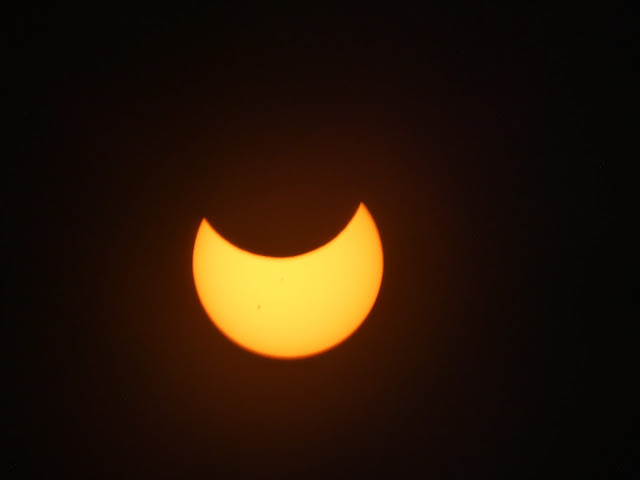 |
| Today's eclipse at the greatest coverage of the Sun, about 80% |
There was an eclipse today! This is perhaps not entirely news to my North American readers, as the eclipse was visible to some extent across the entire United States. The eclipse was not a total eclipse, as the Moon was farther from the Earth, and could not completely cover the disk of the Sun. This is called an annular eclipse. Those on the main path of the eclipse were treated with the "ring of fire" effect, as the edge of the Sun formed a perfect ring around the Moon. I didn't have the opportunity to be in that area, so I've settled for the "near miss" of about 80% coverage of the Sun.To see the eclipse, one needed merely to go outside and hope it wasn't cloudy, but Mrs. Geotripper and I wanted to make the day a bit more special, so we headed out to the San Luis National Wildlife Refuge where we could see things in a setting resembling the primeval environment of California's Great Valley. We got to observe some of the early-arriving migrant birds like the Sandhill Cranes, Greater White-fronted Geese, and Snow Geese.
 |
| Sandhill Cranes at the San Luis National Wildlife Refuge |
We were a bit curious if the bird behavior would be affected by the darkening skies, as sometimes happens with total eclipses, but we didn't notice anything unusual.
The entire affair unfolded over about two hours, so we drove the auto-tour route at the refuge, stopping to take pictures of the progress every fifteen minutes or so. This was far less stressful than my two experiences with total eclipses when totality lasted only a few short minutes, and much had to happen to get pictures. Our experience with the total eclipse in 2017 was stressful (and crowded), yet spectacular. Today was peaceful and we had the refuge to ourselves.
The sky must have darkened when 80% of the solar disk was covered by the Moon today, but it wasn't really noticeable. It happened so gradually. When we experienced a total eclipse in Baja in 1991 (see the pictures and story here), at totality the sky turned dark as night, stars became visible, and the temperature dropped around 20 degrees in mere moments.
As the last hour progressed, more and more of the Sun became visible, and soon it seemed like a relatively normal day. The dragon had not consumed the life-giving Sun, and life could go on!





1 comment:
Nice shot of the cranes!!
Post a Comment